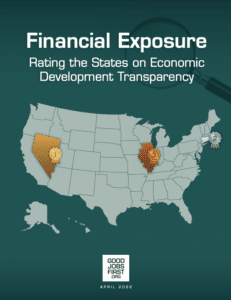 An evaluation of 250 major state-level economic development programs across all 50 states and the District of Columbia found that 154 of those programs—or 62%—disclose which companies receive public support, while 96 do not. But almost every state knows how to disclose and does so: 48 states plus the District of Columbia—or 96%—provide some degree of recipient disclosure. The gap reflects how inconsistent states are in reporting on all their major programs.
An evaluation of 250 major state-level economic development programs across all 50 states and the District of Columbia found that 154 of those programs—or 62%—disclose which companies receive public support, while 96 do not. But almost every state knows how to disclose and does so: 48 states plus the District of Columbia—or 96%—provide some degree of recipient disclosure. The gap reflects how inconsistent states are in reporting on all their major programs.
All State Appendices (with scoring methodology) PDF
Individual state appendices with program scoring details. Programs could receive a maximum score of 100:
Alabama
Score: 0.0/100
Alaska
Score: 16.3/100
Arizona
Score: 22.6/100
Arkansas
Score: 6.0/100
California
Score: 31.0/100
Colorado
Score: 26.5/100
Connecticut
Score: 51.6/100
Delaware
Score: 5.0/100
District of Columbia
Score: 12.0/100
Florida
Score: 32.0/100
Georgia
Score: 0.0/100
Hawaii
Score: 5.8/100
Idaho
Score: 5.6/100
Illinois
Score: 46.4/100
Indiana
Score: 44.6/100
Iowa
Score: 28.4/100
Kansas
Score: 28.8/100
Kentucky
Score: 32.6/100
Louisiana
Score: 28.6/100
Maine
Score: 2.4/100
Maryland
Score: 25.2/100
Massachusetts
Score: 16.6/100
Michigan
Score: 41.4/100
Minnesota
Score: 17.4/100
Mississippi
Score: 8.4/100
Missouri
Score: 22.6/100
Montana
Score: 23.0/100
Nebraska
Score: 13.0/100
Nevada
Score: 63.6/100
New Hampshire
Score: 2.6/100
New Jersey
Score: 22.0/100
New Mexico
Score: 9.8/100
New York
Score: 41.2/100
North Carolina
Score: 41.8/100
North Dakota
Score: 2.4/100
Ohio
Score: 21.6/100
Oklahoma
Score: 10.2/100
Oregon
Score: 32.0/100
Pennsylvania
Score: 18.4/100
Rhode Island
Score: 13.6/100
South Carolina
Score: 22.8/100
South Dakota
Score: 14.6/100
Tennessee
Score: 9.6/100
Texas
Score: 35.8/100
Utah
Score: 8.6/100
Vermont
Score: 24.2/100
Virginia
Score: 44.8/100
Washington
Score: 30.8/100
West Virginia
Score: 8.0/100
Wisconsin
Score: 39.2/100
Wyoming
Score: 9.4/100
Read our 2014 report, “Show Us the Subsidized Jobs.” Among the report’s key findings:
- Forty-six states and the District of Columbia provide online recipient disclosure for at least one key subsidy program. This is up from 37 in late 2010 and 23 in 2007.
- The states with the best average program scores are: Illinois (65), Michigan (58), North Carolina (48), Wisconsin (46), Vermont (43), Maryland (42) and Texas (40). The most-improved state is Oregon, which had no disclosure in 2010 and is now in the top ten with an average of 38.
- The four states still lacking online disclosure are: Arkansas, Delaware, Idaho and Kansas.
Read our 2010 report, “Show Us the Subsidies.” Among the report’s key findings:
- Thirty-seven states provide online recipient disclosure for at least one key subsidy program.
- Based on our scoring system, the states with the best averages across their programs are: Illinois (82), Wisconsin (71), North Carolina (69) and Ohio (66).
- Thirteen states and the District of Columbia currently have no disclosure at all, although one of those states, Massachusetts, is slated to come online as enacted legislation takes effect.